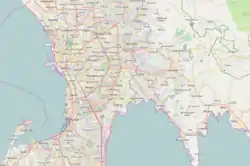Carriedo station
Carriedo station is a station on the Manila Light Rail Transit System Line 1. Like all other Line 1 stations, Carriedo station is above-ground. The station is located in Santa Cruz in Manila. The station is named after Carriedo Street, which crosses below it. It is the only station in the entire line with a canopy roof.
 | |||||||||||
| Location | Rizal Avenue cor. Carriedo Street Santa Cruz and Quiapo, Manila Philippines | ||||||||||
| Owned by | Department of Transportation Light Rail Manila Corporation | ||||||||||
| Line(s) | Line 1 | ||||||||||
| Platforms | Side platforms | ||||||||||
| Tracks | 2 | ||||||||||
| Connections | Buses, jeepneys, taxis, cycle rickshaws, and kalesas | ||||||||||
| Construction | |||||||||||
| Structure type | Viaduct | ||||||||||
| Other information | |||||||||||
| Station code | CA | ||||||||||
| History | |||||||||||
| Opened | May 12, 1985 | ||||||||||
| Services | |||||||||||
| |||||||||||
| Location | |||||||||||
 Carriedo Location within Metro Manila | |||||||||||
Carriedo station is the first station north of the Pasig River and is the tenth station for trains headed to Roosevelt and the eleventh station for trains headed to Baclaran.
The station is near to some famous Manila landmarks, such as the Santa Cruz Church, Quiapo Church, home to very festive celebrations of the Feast of the Black Nazarene, as well as the famed Escolta Street and Plaza Lacson, the former hub of Manila's business activities, and Ongpin Street, home to many Chinese stores selling everything from food to medicine. Adjacent to the station as well are shopping centers, like Isetann Carriedo, Good Earth Plaza, Plaza Fair, and SM Quiapo. It is also close to the Liwasang Bonifacio, the Manila Central Post Office, which is the base of operations for the Philippine Postal Corporation, and FEATI University.
Under the station's train port was an empty space used as a location for a detour in The Amazing Race Asia 2.
Transportation links
Due to Carriedo station's location being near three districts, namely, Santa Cruz, Binondo, and Quiapo, the station is served by many forms of public transport. Buses serving the Taft Avenue and Rizal Avenue routes and nearby routes, jeepneys, taxis, tricycles, and kalesas stop at and around the station. Kalesas and tricycles are particularly used in Binondo, due to the district's narrow streets.